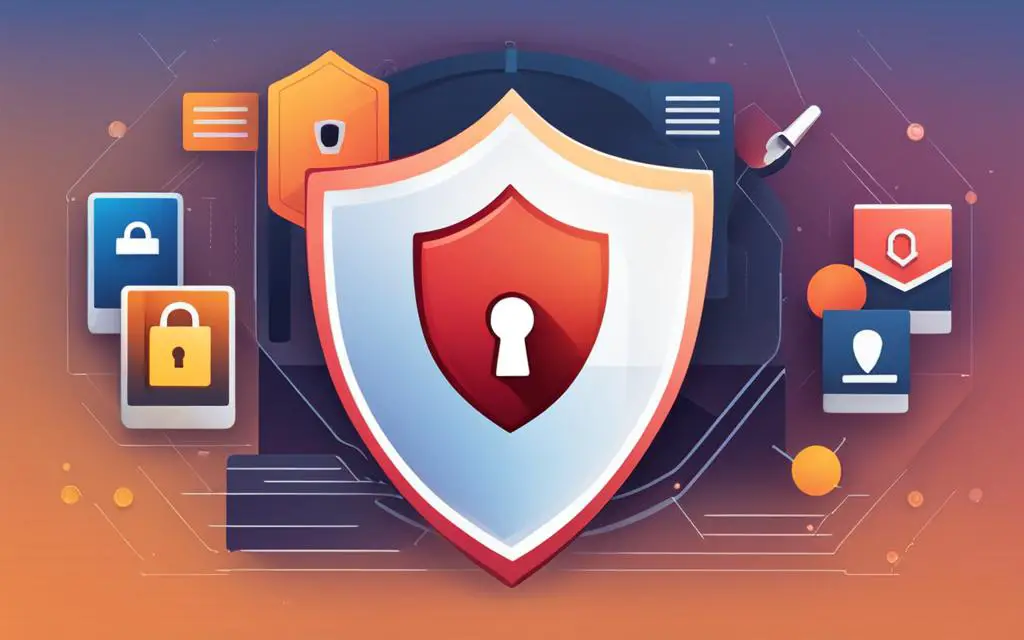Cyber threats are a constant concern in today’s interconnected world. With the ever-increasing number of online scams and predators, it is crucial to prioritize your online security. This Cyber Threats Guide will equip you with the essential knowledge and Cyber Threat Prevention Tips to protect yourself against cybersecurity threats.
Think Like a Hacker
When it comes to protecting yourself from cyber threats, it’s essential to think like a hacker. By understanding their mindset and tactics, you can better fortify your defenses. Brett Johnson, a former cybercriminal, emphasizes the importance of recognizing your position in the cybercrime spectrum. This means understanding how hackers view potential targets, identify vulnerabilities, and exploit them for personal gain.
Thinking like a hacker involves adopting a proactive mindset that anticipates their strategies. It means considering the various ways in which hackers can infiltrate your digital life and taking steps to minimize your vulnerability. By putting yourself in a hacker’s shoes, you can identify potential weaknesses in your online presence and take the necessary precautions to protect yourself.
One effective approach to thinking like a hacker is to conduct a thorough assessment of your online security. Evaluate your current practices, such as password strength, software updates, and vulnerability to phishing scams. By identifying areas where you may be susceptible to attack, you can take targeted action to strengthen your defenses.
Remember, thinking like a hacker is not about engaging in illegal activities or adopting a malicious mindset. It’s about gaining insight into the methods used by cybercriminals and using that knowledge to safeguard your digital assets. By thinking like a hacker, you can stay one step ahead and build a robust defense against cyber threats.
Table: Common Hacker Tactics and Countermeasures
| Hacker Tactics | Countermeasures |
|---|---|
| Social Engineering | Train employees to recognize and report phishing attempts. Implement strict access controls and multifactor authentication. |
| Malware Attacks | Regularly update antivirus software and operating systems. Exercise caution when downloading files or clicking on suspicious links. |
| Password Cracking | Use strong, unique passwords for each account. Enable two-factor authentication whenever possible. |
| Zero-Day Exploits | Stay up to date with software patches and security updates. Implement intrusion detection systems and firewalls. |
| Data Breaches | Regularly monitor and review your accounts for any signs of unauthorized access. Encrypt sensitive data and implement robust access controls. |
By thinking like a hacker and implementing countermeasures, you can significantly strengthen your online security and protect yourself from cyber threats. Stay vigilant, stay informed, and stay one step ahead of those who seek to exploit your digital presence.
Protect Yourself like One
In today’s digital landscape, protecting yourself against cyber threats is more important than ever. Implementing robust security measures can help ensure your online safety and guard against potential cybersecurity threats. By following these essential steps, you can significantly enhance your online protection.
Use a Password Manager
One of the most crucial steps you can take to protect yourself online is to use a password manager. A password manager generates strong and unique passwords for each of your online accounts, reducing the risk of unauthorized access. It securely stores your passwords and automatically fills them in when needed, making it easy to maintain strong security practices. With a password manager, you can take control of your online security and ensure that your accounts remain protected.
Monitor Your Credit
Cybercriminals often target personal and financial information to carry out identity theft and fraud. Monitoring your credit regularly is a proactive way to detect any suspicious activity quickly. By reviewing your credit reports and keeping an eye out for any unauthorized transactions or accounts, you can take swift action to mitigate potential risks and protect your financial well-being. Consider signing up for credit monitoring services or using free credit report services to stay informed and stay one step ahead of cyber threats.
Freeze Your Credit
Freezing your credit is another effective way to prevent unauthorized access to your personal information. A credit freeze restricts access to your credit report, making it difficult for cybercriminals to open new accounts using your identity. By placing a freeze on your credit, you can add an extra layer of security to your financial profile and guard against potential cybersecurity threats. It’s important to note that freezing your credit may come with certain inconveniences, such as temporarily restricting your ability to open new credit accounts. However, the benefits of enhanced security far outweigh these temporary inconveniences.
Protecting yourself against cyber threats should be a top priority in today’s interconnected world. By implementing these essential steps, including using a password manager, monitoring your credit, and freezing your credit, you can significantly enhance your online security and guard against potential cybersecurity threats. Stay proactive and remain cybersmart to keep your personal information safe.
Treat Social Media like the Threat It Is
Social media platforms have become an integral part of our daily lives, allowing us to connect with friends, share personal moments, and stay updated on current events. However, it’s important to remember that social media can also pose significant risks to your online security. Cybercriminals often exploit the openness and trust within these platforms to gather personal information and carry out targeted attacks.
To protect yourself from potential threats on social media, it’s crucial to adopt a cautious approach. Start by reviewing and adjusting your privacy settings to limit the amount of personal information visible to others. Be mindful of the content you post, as even seemingly innocent details can be used to gather information for phishing attempts or identity theft.
Additionally, it’s essential to be selective with the people you connect with online. Be wary of accepting friend requests from individuals you don’t know or trust. Cybercriminals may create fake profiles to gain access to your personal details or launch social engineering attacks.

Protecting Your Privacy on Social Media
- Review and adjust privacy settings to limit personal information visibility.
- Think twice before posting personal details that can be used for phishing or identity theft.
- Be cautious when accepting friend requests from unfamiliar individuals.
- Avoid sharing sensitive information, such as your address or financial details, publicly.
- Regularly monitor your account for any suspicious activity or unauthorized access.
Remember, social media is a valuable target for cybercriminals, so always treat it as a potential threat to your online security. By taking the necessary precautions and being vigilant, you can enjoy the benefits of social media while keeping your personal information safe.
Protect Yourself Online
In today’s digital age, it’s more important than ever to take proactive steps to protect yourself online. By implementing a few simple practices, you can significantly reduce the risk of falling victim to cyber threats. Here are some essential cyber threat prevention tips to keep in mind:
- Enable Multifactor Authentication: Adding an extra layer of security to your online accounts can make it much harder for hackers to gain access. Enable multifactor authentication whenever possible, requiring a second form of verification, such as a unique code sent to your phone, when logging in.
- Regularly Update Software: Keeping your operating system, web browsers, and other software up to date is crucial for maintaining a secure online environment. Software updates often include important security patches that address vulnerabilities that cybercriminals could exploit.
- Be Vigilant Against Phishing Scams: Phishing scams are a common tactic used by cybercriminals to trick unsuspecting individuals into revealing sensitive information. Be cautious of unsolicited emails, messages, or phone calls asking for personal or financial information. Verify the legitimacy of any requests before providing any sensitive data.
By implementing these cyber threat prevention tips, you can significantly enhance your online security and reduce the likelihood of falling victim to cyber scams and attacks. Remember, staying proactive is key when it comes to protecting yourself online.
Protecting Your Personal Information Online
In addition to the precautions mentioned above, it’s essential to be mindful of how you share and protect your personal information online. Here are some additional steps you can take to safeguard your data:
- Review Privacy Settings: Regularly review the privacy settings on your social media accounts, ensuring that only approved individuals can access your personal information, posts, and photos.
- Use Strong, Unique Passwords: Create strong and unique passwords for all your online accounts. Avoid using common phrases or easily guessable information, such as your birthdate or pet’s name.
- Monitor Your Credit: Stay vigilant by regularly monitoring your credit reports for any suspicious activity. If you notice any unauthorized transactions or accounts, report them immediately to the appropriate authorities.
By following these practices and staying informed about the latest cyber threats, you can better protect your personal information and reduce the risk of becoming a victim of cybercrime. Remember, your online security is in your hands, so stay informed and stay safe.
| Cyber Threat Prevention Tips | Benefits |
|---|---|
| Enable Multifactor Authentication | Enhances account security by requiring an additional layer of verification |
| Regularly Update Software | Maintains a secure online environment by applying security patches and bug fixes |
| Be Vigilant Against Phishing Scams | Protects against social engineering attacks that attempt to steal personal information |
| Review Privacy Settings | Controls the visibility of personal information on social media platforms |
| Use Strong, Unique Passwords | Prevents unauthorized access to online accounts by creating robust login credentials |
| Monitor Your Credit | Detects and addresses any suspicious activity related to your financial accounts |

Stay Informed About New Scams and Cyber Threats
As the cyber threat landscape continues to evolve, it is crucial to stay informed about the latest scams and cyber threats. By staying up to date, you can better protect yourself and minimize the risk of falling victim to online attacks. Here are some key strategies to help you stay informed:
- Follow reliable cybersecurity news sources: Stay connected with reputable cybersecurity news websites, blogs, and publications. These sources provide regular updates on emerging threats, new hacking techniques, and security vulnerabilities.
- Sign up for alerts and newsletters: Many cybersecurity organizations and experts offer alerts and newsletters that provide valuable insights into the latest cyber threats. By subscribing to these resources, you can receive timely notifications and actionable information to enhance your online security.
- Join online security communities: Engage with online security communities and forums to stay connected with like-minded individuals who are passionate about cybersecurity. These communities often share valuable insights, news, and discussions on the latest scams and threats.
Remember, being proactive and staying informed are essential in the fight against cyber threats. By staying up to date with the latest developments, you can stay one step ahead of cybercriminals and protect yourself and your digital assets effectively.
Additional Resources:
“Cyber Threats: The Ultimate Guide to Protecting Your Online Security” – A comprehensive ebook that covers various cyber threats, prevention techniques, and best practices for online security.
“10 Cyber Threats You Should Know About in 2021” – A recent article that highlights the top cyber threats to be aware of this year and provides insights on how to protect yourself from them.
| Threat Type | Description | Tips for Protection |
|---|---|---|
| Phishing | A fraudulent attempt to obtain sensitive information by disguising as a trustworthy entity. | Be cautious of suspicious emails, links, and attachments. Verify the sender’s identity before sharing personal information. |
| Ransomware | Malicious software that encrypts your files and demands a ransom for their release. | Regularly backup your important files. Keep your operating system and antivirus software up to date. |
| Malware | Malicious software designed to harm your computer or steal sensitive information. | Install reputable antivirus software. Avoid downloading files from unknown sources or clicking on suspicious ads. |
Conclusion
Protecting yourself against cyber threats is an ongoing endeavor that demands constant vigilance and proactive measures. By adopting the mindset of a hacker, implementing robust security practices, being cautious on social media, and staying informed about the latest scams and threats, you can significantly enhance your online security.
Thinking like a hacker allows you to anticipate the strategies they might employ, making it easier to safeguard yourself from different types of attacks. By understanding their methods, you can better protect your personal information and minimize your vulnerability to cyber threats.
Implementing strong security measures, such as using a password manager, monitoring your credit for suspicious activity, and freezing your credit when needed, provides an additional layer of protection. These actions help ensure that your personal and financial data remains secure, mitigating the risk of unauthorized access.
Furthermore, it’s crucial to exercise caution on social media platforms, carefully managing the content you share, reviewing privacy settings, and being selective about your connections. By proactively managing your online presence, you can minimize the risk of falling prey to cybercriminals seeking personal information.
Remember, protecting your digital presence requires continuous effort and staying informed about the evolving cyber landscape. By enabling multifactor authentication, keeping your software up to date, and being vigilant against phishing scams, you can significantly reduce the likelihood of becoming a victim of cyber threats.
Stay proactive and remain cybersmart. Safeguarding your online security is paramount in today’s interconnected world. By following this Cyber Threats Guide and implementing the recommended preventive tips, you can safeguard your digital identity and enjoy a safer online experience.
Source Links
- https://www.cisa.gov/news-events/news/4-things-you-can-do-keep-yourself-cyber-safe
- https://money.com/how-to-protect-yourself-online/
- https://consumer.ftc.gov/consumer-alerts/2021/06/your-guide-protecting-your-privacy-online





